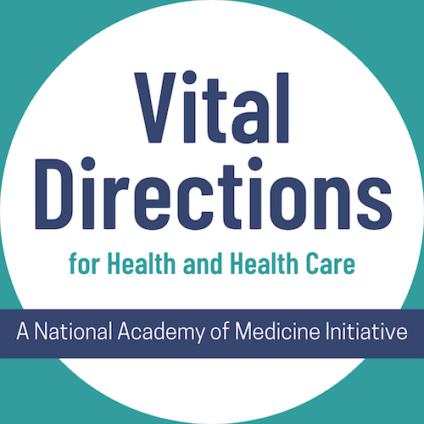Vital Directions for Health and Health Care
Lorem ipsum dolor sit amet


A Policy Initiative of the National Academy of Medicine
The National Academy of Medicine’s (NAM) Vital Directions for Health and Health Care policy initiative aims to provide the U.S. Presidential Administration, as well as other policy makers, opinion leaders, and the public, with trusted, nonpartisan, evidence-based analysis of the most compelling opportunities and priorities in health, health care, and biomedical science.
In anticipation of the 2016 Presidential election, the NAM saw a need for a trusted, independent, and objective source to: 1) call attention to the highest-priority issues in American health and health care; 2) compile expert, evidence-based insights and recommendations for policy and practice around each issue; and 3) strengthen bridges among policy makers and health experts to share information, foster consensus, and guide policy. The 2017 capstone publication presents a vision of an optimized health system, along with a streamlined framework—built on a core set of eight strategic action priorities and essential infrastructure needs identified by the Vital Directions Steering Committee.
Vital Directions for Health and Health Care: Priorities for 2021
With the NAM’s Congressionally-charted responsibility as advisor to the nation, the four-year cycles of the presidential term offer the occasion for renewed assessment by the NAM of the nation’s opportunities and priorities in health and health care. Since the 2017 Vital Directions seminal publication, much has happened in health and health care, underscoring concerns about the nation’s persistent challenges related to maternal mortality, the opioid crisis, and pervasive health inequities, among others. In anticipation of the next four-year cycle, and as we entered the next phase of this initiative in 2020, the NAM is undertaking a more abbreviated, but important, updated assessment on key priorities and issues of urgent attention for the next Administration.
Building on the initial Vital Directions effort, the NAM marshaled guidance from over 30 experts to address five high priority issues that have a particularly compelling need for attention, with each article reviewing trends, analysis of the challenge, and potential actions. The collection of articles, published in Health Affairs, also reflects the current experience with both the coronavirus disease 2019 (COVID-19) pandemic and the health inequities that have been drawn out sharply by COVID-19, as well as the implications going forward for action.

Read the Health Affairs Articles Below
One Page Summaries
Vital Directions for Health and Health Care: The North Carolina Experience
Vital Directions for Health and Health Care: Priorities for 2017
Co-chaired by NAM President Victor J. Dzau and Mark McClellan, director of the Duke-Margolis Center for Health Policy, and guided by an 18-member bipartisan steering committee, the foundational Vital Directions for Health and Health Care effort drew on more than 150 experts from across the country who authored expert, peer-reviewed papers with policy recommendations in 19 key areas important to three areas: better health and well-being, high-value health care, and strong science and technology. In addition, the Journal of the American Medical Association published summaries (or “Viewpoints”) of each paper.
The 2017 capstone publication, containing the Steering Committee’s synthesis along with the 19 discussion papers, presents a vision of an optimized health system together with a streamlined framework—built on a core set of eight strategic action priorities and essential infrastructure needs identified by the Vital Directions Steering Committee. Included are four action priorities—pay for value, empower people, activate communities, and connect care—that represent direct and strategic opportunities to advance a more efficient, equitable, and patient- and community-focused health system. Four essential infrastructure needs—measure what matters most, modernize skills, accelerate real-world evidence, and advance science—represent foundational elements for future progress.
As the nation continues to face growing challenges in health and health care—such as inequitable access and quality of care and increased spending—this framework provides expert guidance on many issues that continue to plague the United States, and can be used by decision-makers in implementing policy that addresses these concerns.
Program Resources

Program News

Staff





Sponsors
Have Questions?
Get in Touch
For more information about the National Academy of Medicine, please contact us.
